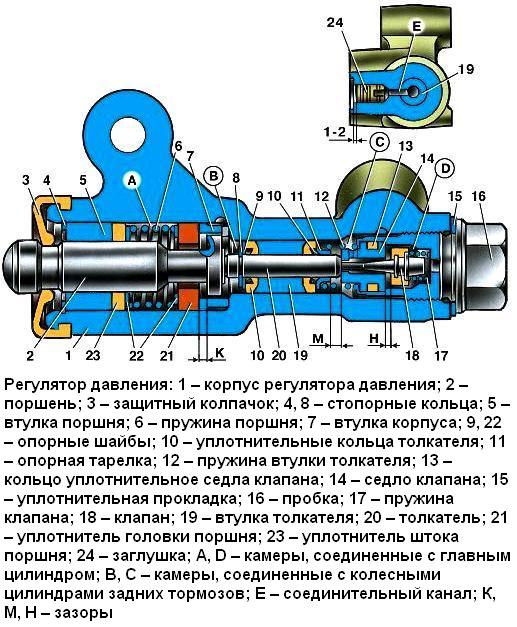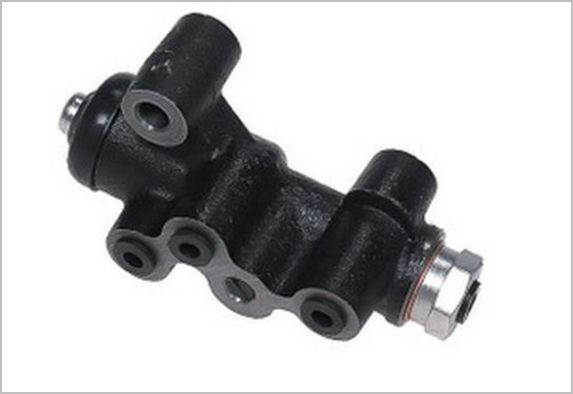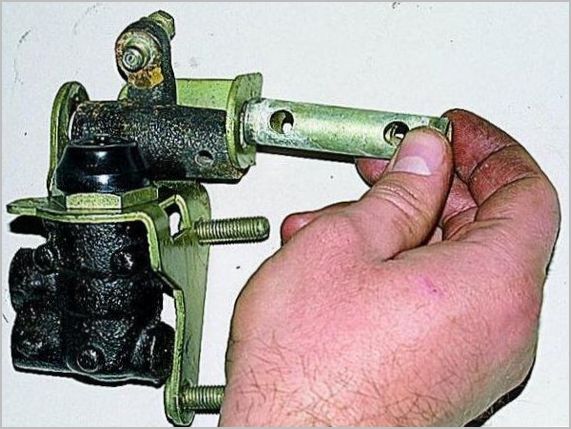
Brake force regulator - device and principle of operation
Content
When the car brakes, the effect of dynamic redistribution of the car's weight between the front and rear axles occurs. Since the maximum achievable friction force between the tire and the road depends on the grip weight, it decreases on the rear axle, increasing for the front. In order not to break the rear wheels into a slip, which will certainly lead to a dangerous skid of the car, it is necessary to redistribute the braking forces. This is quite easily implemented using modern systems associated with ABS units - anti-lock braking system. But the cars of the past had nothing of the kind, and this function was performed by hydromechanical devices.

What is a brake force regulator?
In addition to the described case, which requires emergency intervention in the operation of the brakes, it is also necessary to regulate the retarding force to optimize the braking process itself. The front wheels are well loaded, they could add pressure in the working cylinders. But a simple increase in the force of pressing the pedal will lead to the consequences already indicated. It is necessary to reduce the applied pressure in the rear mechanisms. And to do it automatically, the driver will not be able to cope with continuous tracking along the axes. Only trained motorsportsmen are capable of this, and only when passing through a “targeted” turn with a given braking point and a known coefficient of adhesion to the road.
In addition, the car can be loaded, and this is done unevenly along the axes. The luggage compartment, truck body and rear passenger seats are located closer to the stern. It turns out that an empty car and without a dynamic change in the back has no grip weight, but in front it is in excess. This also needs to be tracked. A brake balancer used in motorsports can help here, since the loads are known before the trip. But it would be wiser to use an automaton that will work both in statics and in dynamics. And he can take the necessary information from the degree of change in the position of the body above the road as part of the working stroke of the rear suspension.
How the regulator works
With outward simplicity, the principle of operation of the device is incomprehensible to many, for which he was nicknamed the "sorcerer". But there is nothing prohibitively complicated in his actions.
The regulator is located in the space above the rear axle and consists of several elements:
- housings with internal cavities filled with brake fluid;
- a torsion lever connecting the device to the body;
- a piston with a pusher acting on a restrictive valve;
- pressure control valve in the rear axle cylinders.

Two forces act on the piston - the pressure of the brake fluid pumped by the driver through the pedal, and the lever that monitors the torque of the torsion bar. This moment is proportional to the position of the body relative to the road, that is, the load on the rear axle. On the reverse side, the piston is balanced by a return spring.
When the body is low above the road, that is, the car is loaded, there is no braking, the suspension is compressed as much as possible, then the path of the brake fluid through the valve is completely open. The brakes are designed in such a way that the rear brakes are always less effective than the front ones, but in this case they are fully used.

If we consider the second extreme case, that is, the empty body does not load the suspension, and the braking that has begun will take it away from the road even more, then the piston and valve, on the contrary, will block the fluid path to the cylinders as much as possible, the braking efficiency of the rear axle will be reduced to a safe level. This is well known to many inexperienced repairmen who have tried to bleed the rear brakes on a suspended car. The regulator simply does not allow this, closing the fluid flow. Between the two extreme points there is a pressure regulation controlled by the position of the suspension, which is required from this simple device. But it also needs to be adjusted, at least during installation or replacement.
Setting up the "sorcerer"
Checking the normal operation of the regulator is quite simple. Having accelerated on a slippery surface, the driver presses the brake, and the assistant visually captures the moments when the front and rear wheels start to lock. If the rear axle starts sliding earlier, the sorcerer is faulty or needs to be adjusted. If the rear wheels do not block at all, it’s also bad, the regulator has overdone it, it needs to be corrected or replaced.

The position of the device body relative to the torsion lever is adjusted, for which the mount has some freedom. Usually, the clearance value on the piston is indicated, which is set at a certain position of the rear axle relative to the body. After that, most often additional adjustments are not required. But if the test on the road showed insufficient efficiency of the regulator operation, the position of its body can be adjusted more precisely by loosening the fasteners and shifting the body in the right direction, to twist the torsion bar or relax. To increase the pressure on the piston or reduce it is easy to understand by looking at the place how it changes when the rear axle is loaded.
There is no place for optimism in the work of the brakes
Many cars continue to drive with the regulator soured tightly, because their owners do not understand the full role of this simple device and are not even aware of its existence at all. It turns out that the operation of the rear brakes depends on the position of the regulator piston in which it soured and lost mobility. The car will either lose a lot in braking efficiency, in fact only the front axle works, or vice versa, it constantly throws the rear during heavy braking due to the incipient skid. This can only pass with impunity until the first emergency braking from high speed. After that, the driver will not even have time to understand anything, so quickly it will turn out to be a trunk flying into the oncoming lane ahead.
The operation of the regulator must be checked at each maintenance according to the instructions. The piston must be mobile, the clearance must be correct. And bench indicators correspond to passport data. Eliminates these procedures only by the fact that the "sorcerer" has not been used in modern cars for a long time, and its role is assigned to an electronic system arranged and tested in completely different ways. But when buying an old car, the presence of such a device should be remembered.

